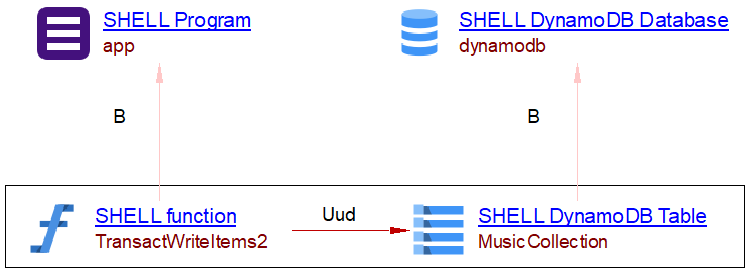Support of DynamoDB for Shell
CAST supports DynamoDB via its com.castsoftware.shell extension. Details about how this support is provided for Shell source code is discussed below.
Supported versions
| Versions | Supported |
|---|---|
| V1 | |
| V2 |
Supported commands
All commands listed below have as caller a Shell Program or Function and as callee a SHELL AWS (Unknown) DynamoDB Table:
| API (with CRUD links) | Link Type | Remark |
|---|---|---|
| aws dynamodb get-item | useSelectLink | - |
| aws dynamodb scan | useSelectLink | - |
| aws dynamodb query | useSelectLink | - |
| aws dynamodb create-backup | useSelectLink | - |
| aws dynamodb batch-get-item | useSelectLink | Only inline json input data supported |
| aws dynamodb batch-write-item | useInsertLink, useDeleteLink | Only inline json input data supported |
| aws dynamodb restore-table-to-point-in-time | useSelectLink, useInsertLink | - |
| aws dynamodb restore-table-from-backup | useUpdateLink | - |
| aws dynamodb delete-table | useDeleteLink | - |
| aws dynamodb delete-item | useDeleteLink | - |
| aws dynamodb transact-write-items | useUpdateLink, useDeleteLink | Only inline json input data supported |
| aws dynamodb update-item | useUpdateLink | - |
| aws dynamodb update-table | useUpdateLink | - |
| aws dynamodb put-item | useUpdateLink, useInsertLink | - |
| API | Effect |
|---|---|
| aws dynamodb create-table | A DynamoDB table is created |
| aws dynamodb create-global-table | A DynamoDB table is created |
Objects
Objects created specific for DynamoDB AWS service interpretation:
| Icon | Metamodel Name |
|---|---|
|
Shell AWS DynamoDB Database |
|
Shell AWS DynamoDB Table |
|
Shell AWS Unknown DynamoDB Table |
What results can you expect?
A DynamoDB Table object can be created by two different situations. In the first one, explicit creation of tables is detected by the presence of create-table or create-global-table commands and therefore bookmarked to the corresponding command string. In the second situation, there is no explicit table creation, but references to tables are present in different commands. In this case, a DynamoDB Table object is created by reference and all references are bookmarked into the object.
When the name of a table is not resolved (either because of absence of information or technical limitations) a Shell AWS Unknown DynamoDB Table is created instead. A single unknown table is created per project.
Below we illustrate the expected results with various examples:
Example 1
The following code in a file app.sh contains a single aws-dynamodb command enclosed in a Shell Function (GetItem) requesting an item from a DynamoDB table of name ProductCatalog:
#!/bin/sh
GetItem () {
aws dynamodb get-item --table-name ProductCatalog --key '{"Id": {"N": "102"}}' --projection-expression "#T, #C, #P" --expression-attribute-names file://names.json
}
As a result, a Shell AWS DynamobDB Table is created after the reference to the table, together with a parent Shell AWS DynamoDB Database objet. A link is also created of type useSelectLink between the caller GetItem function and the table.

Note that a single Shell AWS DynamoDB Database objet is created per project (if Shell AWS DynamoDB Tables are present).
Example 2
The following code in a file app.sh contains a single aws-dynamodb command enclosed in a Shell Function (TransactWriteItems2) writing and deleting items (details are omitted for simplicity) from a DynamoDB table of name MusicCollection:
#!/bin/sh
TransactWriteItems2() {
aws dynamodb transact-write-items --transact-items '[{"Update": {"TableName": "MusicCollection"}},{"Delete": {"TableName": "MusicCollection"}}]' --return-consumed-capacity TOTAL --return-item-collection-metrics SIZE
}
The references to the table are inside the –transact-items argument given as a json string together with the actions (Update, Delete). The analyzer will parse the json input string and create the corresponding objects and links (useUpdateLink and useDeleteLink):

Known Limitations
- Using external .json files as inputs is not yet supported (ex. –transact-items file://transact-items.json)